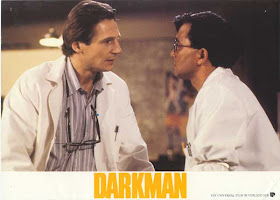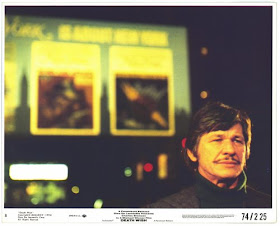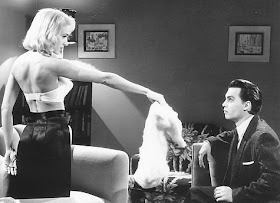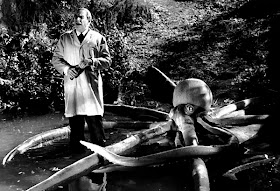
I can remember the months of anticipation back in 1990 waiting for the release of DARKMAN, Sam Raimi’s followup to his masterpiece EVIL DEAD II. The director appeared at the Fangoria convention in New York at the very beginning of the year and I can remember him just hanging out in the back of the auditorium freely chatting with people—I still have the Darkman t-shirt he gave me, though it’s pretty ratty and small by now. But it wasn’t until months later in August at the very end of summer when the film was finally released, backed by a pretty fantastic campaign by Universal that trumpeted “Who is DARKMAN?” I was there for the very first show, after which I snuck into another screen at the multiplex to see MY BLUE HEAVEN. Let’s just say that the afternoon peaked early. I’ve always had a fondness for DARKMAN for all sorts of reasons and it was a blast to see it again this past weekend when the New Beverly ran it at midnight on Saturday because it was New Bev regular Cathie’s birthday. DARKMAN, you see, is Cathie’s favorite movie. Why? Because Cathie is awesome.

Scientist Peyton Westlake (Liam Neeson) is experimenting with a type of synthetic skin that could revolutionize the field but is unable to get the cells to stay together past 99 minutes. Just as he simultaneously is proposing marriage to lawyer girlfriend Julie Hastings (Frances McDormand) as well as achieving a breakthrough in discovering that the skin will stay together in the dark (“What is it about the dark? What secret does it hold?”) everything comes to a sudden end when his lab is broken into by a team of thugs led by mobster Robert G. Durant (Larry Drake) looking for “the Belisarius memorandum” an incriminating document that Julie accidentally left behind which links property developer Louis Strack (Colin Friels) to certain payouts. Durant and his men destroy the lab, presumably killing Westlake in the process. But Westlake managed to survive, only horribly maimed with burns covering much of his body but when brought to a hospital he has his nerves severed so he will not feel pain, an experimental technique that also amplifies the emotions wreaking havoc on his mental state. Recovering what he can from the wreckage of his laboratory, Westlake seeks refuge in an abandoned warehouse and continues his experiments, fully intent on seeking revenge against the ones who destroyed his life using the very process he has been creating.

Seen all these years later, DARKMAN can be looked at as Raimi’s style continuing to develop, moving from what should probably be called the ‘pure cinema’ of EVIL DEAD II towards the more traditional narratives in the films that he directed in the late nineties which of course led to the SPIDER-MAN movies. There’s a slight awkwardness present which comes from the feeling that the film is tossing a massive amount of elements into the mix from Neeson’s huge emoting to the dark comedy involving his character assuming various villain’s identities to lots of bombastic action to whatever is going on between Larry Drake and Ted Raimi’s characters to the more operatic moments involving Friels’ Louis Strack….this could be an even longer run-on sentence and the extreme shifts in tone don’t always feel exactly elegant. I haven’t even delved into the Belisarius memorandum, which is probably one of the more ludicrous excuses for a McGuffin in film history. What holds the movie together isn’t the script, which in fairness is decent (there is also a certain resemblance to ROBOCOP in the plotting) but with multiple writers credited the stitching shows. Instead, it’s Raimi’s clear love for putting it all together. With everything going on, DARKMAN is consistently exciting and all these years after it was made it’s still an absolute blast to watch. There’s something about it’s scrappiness and nuttiness that even now puts a goofy grin on my face and even if the SPIDER-MAN films are probably “better” in a number of ways in another ten years or so I think I’ll still want to see this one instead. Even the Danny Elfman score, which has always been criticized for its BATMAN resemblance, is an extremely successful glue that holds the picture together and is also a nice reminder of when these scores (and these films) were actually, unapologetically fun. You can feel Sam Raimi’s glee throughout from the surveillance camera coverage of the convenience store robbery to Neeson’s breakdown during the carnival sequence, not to mention the more extreme examples of Raimi’s visual style like the celebrated dissolve involving Frances McDormand at a big emotional point. The visual invention is varied and continually unexpected throughout. It’s not perfect and given the choice, I honestly prefer the three EVIL DEAD films to this one but with the massive eagerness it displays to give us the most enjoyable 96 minutes imaginable DARKMAN is still too much fun to have any serious complaints. I’m certainly not going to argue too much with Cathie on this one.

Raimi’s lack of hard experience with actors at that point is apparent at times—he reportedly had problems on the set working with friend Frances McDormand—but even if this is the case it still feels like there’s a greater sensitivity displayed towards the love story than you normally get from this type of film. Neeson, even when his features are covered by make up, is particularly terrific in the physical aspects of his performance. He clearly knows how to work with what Raimi’s camera is doing and seems eager to rise to the challenge. As a matter of fact, having several actors ‘play’ Darkman at various points when he is pretending to be them works very well in each case—issues of body mass are ignored, but so what. Larry Drake, midway through his run on L.A. LAW at this point, is fantastic as Robert G. Durant (“The name isn’t Buddy…”) and succeeds at creating a truly iconic villain. It’s a shame that he never got such a meaty role again--and yes, I’ve seen DR. GIGGLES. Jenny Agutter with her sensuous voice is a good choice to deliver all the necessary exposition in her unbilled role as the burn doctor, Ted Raimi’s cartoonish features are well-utilized and familiar character actor Nicholas Worth is a small standout as Pauly, one of Durant’s henchmen. Maybe the similarity to his other henchman in Wes Craven’s SWAMP THING is what caused me to really notice it but the actor gets a few very funny moments when the film focuses on him for a brief stretch.

The film went over great with the crowd at the New Beverly, with a particularly loud wave of applause coming during the final shot for the cameo of…well, you’ve seen the movie so you don’t need me to tell you. Several months ago I attended a screening of Raimi’s upcoming horror film DRAG ME TO HELL, which I would freely describe as playing like something he made in between DARKMAN and ARMY OF DARKNESS but we were only getting to see it now. Anyone who likes how that sounds probably has something to look forward to. Afterwards I briefly shook hands with him, saying how much I enjoyed it and it was nice to see him still friendly, willing to say hello to his fans after all these years. A midnight show of DARKMAN after all this time is a fun reminder of how eager he’s always been to please the fans who cheer his name. It was definitely a terrific night at the New Beverly and an ideal way to celebrate Cathie’s birthday. Yup.











































